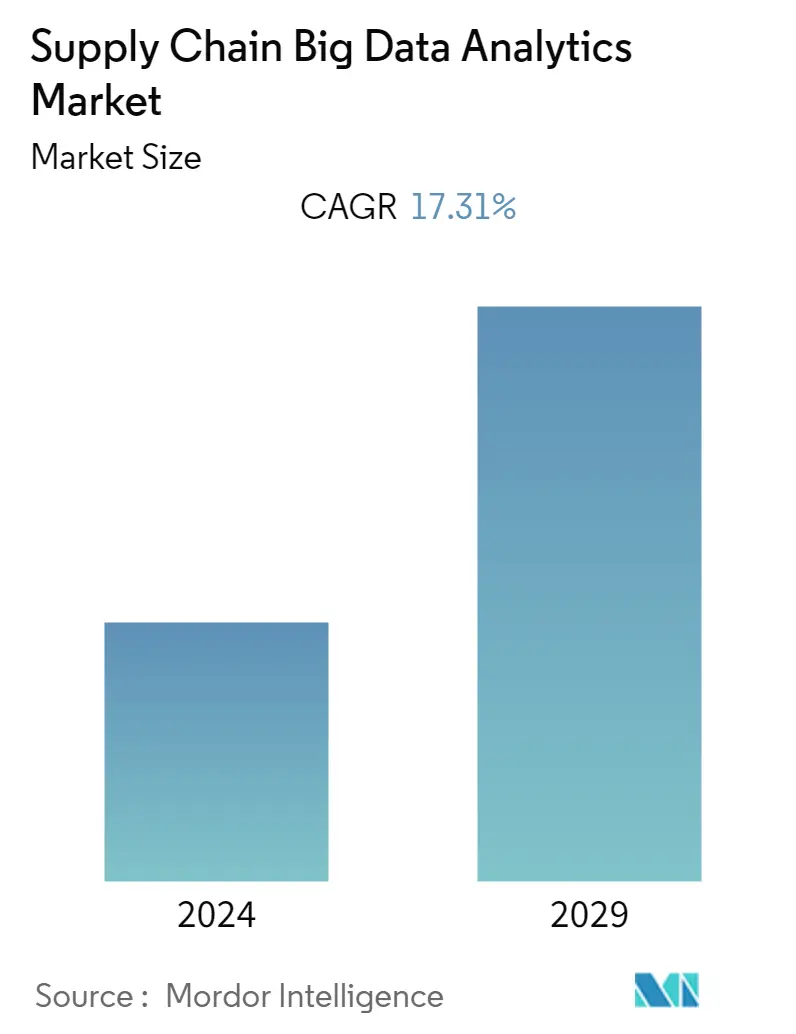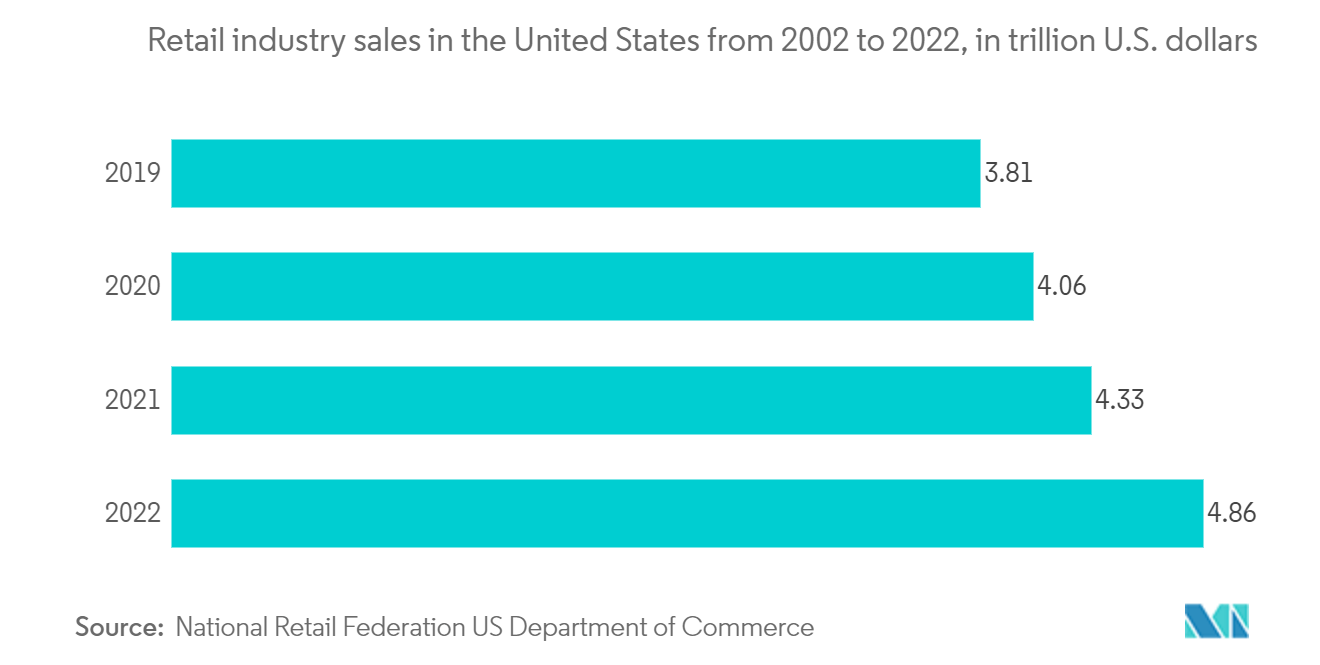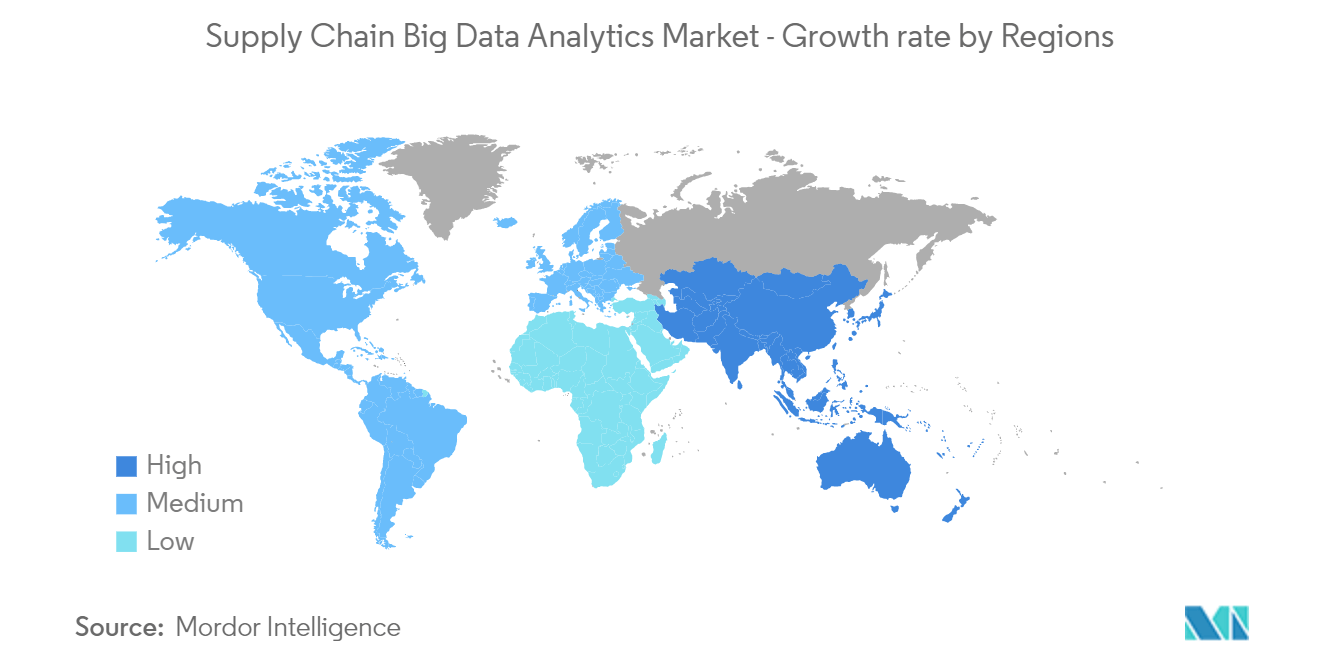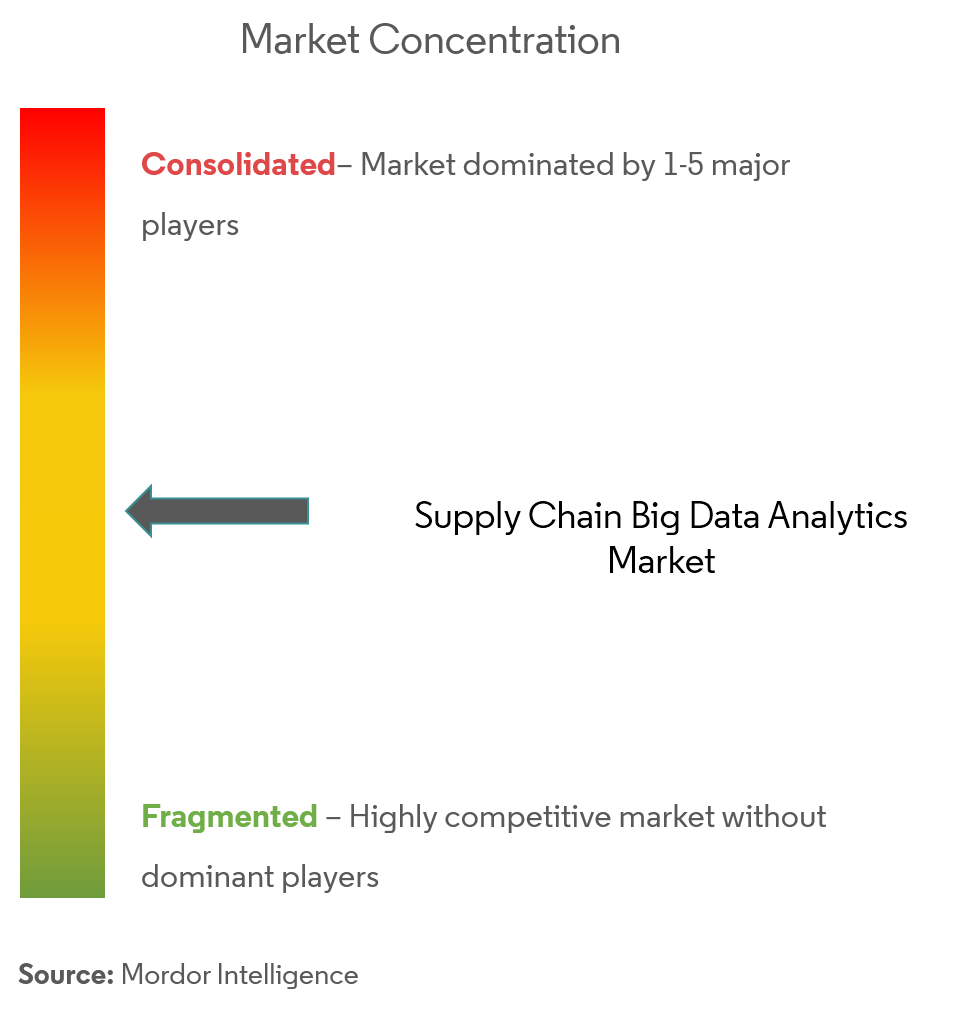Supply Chain Big Data Analytics Market Size

| Study Period | 2019 - 2029 |
| Base Year For Estimation | 2023 |
| CAGR | 17.31 % |
| Fastest Growing Market | Asia Pacific |
| Largest Market | North America |
| Market Concentration | Medium |
Major Players
*Disclaimer: Major Players sorted in no particular order |
Supply Chain Big Data Analytics Market Analysis
Supply Chain Big Data Analytics Market is expected to register a CAGR of approximately 17.31% over the forecast period. With advancements in information technology, firms are now able to access, store, and process a massive amount of data. Organizations are analyzing data sets and identifying key insights to apply to their operations, making it evident that Big Data has an important role to play in any industry. From food and beverage distribution to high tech, companies are incorporating analytics.
- The widespread use of digital technologies has led to the emergence of Big Data Analytics (BDA) as a critical business capability to provide companies with better opportunities to obtain value from an increasingly huge amount of data and gain a commanding competitive advantage.
- Big data analytics aid in the improvement of the supply chain in the manufacturing business. For example, energy-intensive manufacturing runs can be scheduled to take advantage of changing electricity rates. Data on production characteristics, such as assembly forces or size variances between components, can be saved and examined to aid in the root-cause investigation of errors, even if they arise years later. Agricultural seed processors and producers monitor the quality of their products in real-time using various types of cameras to obtain quality assessments for every individual seed.
- Analytics are already being used by trucking businesses to optimize their operations. For example, they employ fuel usage analytics to increase vehicle economy and GPS technology to cut waiting times by distributing storage spaces in real time. Courier companies have begun real-time scheduling of deliveries to consumers based on geo-location and congestion data from their trucks. UPS, for example, has invested ten years in creating its On-Road Integrated Optimization and Navigation system (Orion) to improve the network's 55,000 paths. According to the company's CEO, David Abney, the new method would save $300 million to $400 million yearly. Big data analytics will also assist logistics operators in delivering goods with fewer delivery efforts by mining their data to estimate when a parcel will be delivered.
- Big data analytics can help businesses investigate the sales benefits of grouping related goods together. Google has bought Skybox, a source of high-resolution satellite images that can be used to watch automobiles in a parking lot to predict in-store demand. Others have investigated the use of camera-equipped drones to track on-shelf stock levels.
- The pandemic of COVID-19 has caused disruptions and hazards in global supply systems. Big data analytics (BDA) has recently arisen as a viable solution for providing firms with predicted and pre-emptive information to assist them in planning and reducing the effects of such hazards. The outbreak highlighted the need for solutions for supply chains to ensure long-term economic sustainability. During these difficult times, supply chain analytics helped firms to detect processes that needed immediate adjustment or products/items that were expected to run out soon, helping them to manage the demand-supply gap better. Furthermore, the suppliers are actively developing and delivering solutions to mitigate the detrimental effects of the outbreak on global supply chains.
Supply Chain Big Data Analytics Market Trends
This section covers the major market trends shaping the Supply Chain Big Data Analytics Market according to our research experts:
Retail is Expected to Register a Significant Growth
- The retail industry currently accounts for a significant portion of the supply chain big data analytics market, and it is expected to present numerous growth opportunities as a result of the increasing number of data sources generated by the adoption of IoT solutions, beacons, and RFID technologies throughout the supply chain. Additionally, growing retail sales are expected to drive market growth. For instance, last year, total retail sales in the United States were roughly USD 4.86 trillion, up USD 53 billion from the previous year.
- Retailers may enhance their planning procedures and demand-sensing capacities by utilizing new data sources. Blue Yonder, for instance, has created data-intensive forecasting algorithms already being used in retail, wherein 130,000 SKUs and 200 impacting variables yield 150,000,000 probability distributions each day. This has significantly improved forecast accuracy, provided a better understanding of the firm's logistical capacity requirements, and decreased obsolescence, stock levels, and excess inventory. The recent expansion of third-party cloud-based platforms such as Blue Yonder makes similar activities more available to other retailers.
- Governments worldwide have advised individuals to stay at home and are enacting social distancing regulations, increasing internet purchasing even more. During the pandemic, the demand for analytics solutions in retail has increased dramatically. Walmart, for example, developed Walmart Luminate in 2021, a platform that collects information from Walmart's consumer center and provides insights on perception, audience behavior, and channel success for the numerous brands at Walmart. In October last year, the company announced the forthcoming introduction of a Basic package at no cost to suppliers, making it even more straightforward for suppliers of any scale to engage with merchants to expand their companies. Walmart Luminate Basic is scheduled to go on the market in the current year.
- Furthermore, merchants use IoT solutions and devices to analyze consumer data, manage stock levels, and improve customer interactions. These technological advancements allow for improved monitoring of items across the supply chain and aid in acquiring a clear insight into client behavior.
- For instance, merchants have also installed a system of RFID readers into the ceiling space of the sales floors, enabling them to scan all of the items on show and offering more precise inventory visibility. American Apparel uses RFID tags and data analytics technologies to enhance inventory control, while Walmart uses Big Data analytics to improve in-store and supply-chain management.

North America is Expected to Hold Major Share
- Companies and governments in the United States are constantly working to boost their manufacturing business by increasing productivity and focusing on strengthening operations across the supply chain in the country's manufacturing industry. As the e-commerce business in the United States expands, so does the demand for effective supply chain management. According to the US Commerce Department, the country's e-commerce business grew by 10.8% in the third quarter of the last year. Online orders accounted for over 20.6% of all retail dollars spent.
- The United States is one of the world's largest retail marketplaces, and covid-19 influenced it considerably. However, getting back on track with rising numbers and augmenting growth to keep the momentum going requires advanced tech to evaluate data at that scale. According to the National Retail Federation (NRF), retail is the country's biggest private industry, accounting for USD 3.9 trillion yearly GDP and employing one in every four Americans (52 million).
- According to the US Census Bureau, retail sales in March last year were up 0.5% seasonally adjusted from February and 6.9% Y-O-Y. In February, there were rises of 0.8% month over month and 18.2% Y-O-Y.
- Additionally, E-retailers in the North American retail sector are trying to improve the consumer experience by including same-day delivery, which may be accomplished efficiently with excellent supply chain management.
- Further, regional startups are gathering funds to improve operational efficiency using Big Data analytics and other new technologies. For example, Kharon, an analytics and data company providing companies with intelligence at the intersection of world security and business, announced a partnership with Transparency-One, an international business connectivity and cloud-based platform for distribution network mapping and sub-tier tracking, in September last year. Clients may use Transparency-One to perform product-level distribution network mapping and document monitoring while also automating refused and high-risk party screenings against Kharon's sector Forced Labor database.

Supply Chain Big Data Analytics Industry Overview
The supply chain big data analytics market is highly competitive and consists of several major players. In terms of market share, a few major players currently dominate the market, including SAP SE, IBM Corporation, Oracle Corporation, MicroStrategy Incorporated, and Genpact Limited, among others. These companies leverage strategic collaborative initiatives to increase their market shares and profitability.
In October 2022, Oracle unveiled a slew of new product developments across its complete data and analytics solutions portfolio. With the additional features in Oracle Fusion Analytics for ERP, CX, SCM, and HCM analytics, decision-makers have a prebuilt collection of over 2,000 best-practice dashboards, KPIs, and reports to evaluate performance against strategic objectives. In November 2022, AWS introduced AWS Supply Chain. This new platform enables organizations to supply chain visibility better to make quicker, more informed choices that reduce risks, save money, and enhance customer experiences. AWS Supply Chain seamlessly aggregates and analyzes data from numerous supply chain systems. This allows businesses to monitor their operations in real-time, identify patterns faster, and provide more accurate demand projections to guarantee enough inventory to fulfill consumer expectations.
Supply Chain Big Data Analytics Market Leaders
-
SAP SE
-
IBM Corporation
-
Oracle Corporation
-
MicroStrategy Incorporated
-
Genpact Limited
*Disclaimer: Major Players sorted in no particular order

Supply Chain Big Data Analytics Market News
- September 2022: Accenture announced the acquisition of MacGregor Partner, a prominent supply chain consultant and technology supplier specializing in smart logistics and warehouse administration. It is an intelligent logistics and warehouse management company, as well as a supply chain consultant and technology supplier. Accenture's supply chain network, powered by Blue Yonder technology, has grown due to the acquisition.
- November 2022: o9 Solutions, a supplier of artificial intelligence software platforms for decision-making and planning, and Genpact collaborated to meet the requirement for a digitization process that excludes information silos while transparently integrating and streamlining operations for Eckes - Granini's major European provider of fruit drinks and beverages. The companies recently completed the first part of a project to automate and optimize Eckes Granini's worldwide supply chain.
- November 2022: Microsoft Corp. unveiled the Microsoft Supply Chain System, which aims to help enterprises optimize their supply chain data estate investment through an open approach by combining Microsoft AI, low-code, security, collaboration, and SaaS apps in a scalable platform.
Supply Chain Big Data Analytics Market Report - Table of Contents
1. INTRODUCTION
- 1.1 Study Assumptions
- 1.2 Scope of the Study
2. RESEARCH METHODOLOGY
3. EXECUTIVE SUMMARY
4. MARKET INSIGHTS
- 4.1 Market Overview
-
4.2 Market Drivers
- 4.2.1 Increasing Need of Business Data to Improve Efficiency
-
4.3 Market Restraints
- 4.3.1 Operational Complexity Coupled with High Maintenance Costs
- 4.4 Value Chain / Supply Chain Analysis
-
4.5 Industry Attractiveness - Porter Five Forces
- 4.5.1 Threat of New Entrants
- 4.5.2 Bargaining Power of Buyers/Consumers
- 4.5.3 Bargaining Power of Suppliers
- 4.5.4 Threat of Substitute Products
- 4.5.5 Intensity of Competitive Rivalry
- 4.6 Assessment of the Impact of COVID-19 on the Market
5. MARKET SEGMENTATION
-
5.1 By Type
- 5.1.1 Solution
- 5.1.1.1 Supply Chain Procurement and Planning Tool
- 5.1.1.2 Sales and Operations Planning
- 5.1.1.3 Manufacturing Analytics
- 5.1.1.4 Transportation and Logistics Analytics
- 5.1.1.5 Other Solutions (Inventory Planning and Optimization Analytics and Scheduling and Reporting Tools)
- 5.1.2 Service
- 5.1.2.1 Professional Service
- 5.1.2.2 Support and Maintenance Service
-
5.2 End User
- 5.2.1 Retail
- 5.2.2 Transportation and Logistics
- 5.2.3 Manufacturing
- 5.2.4 Healthcare
- 5.2.5 Other End Users
-
5.3 Geography
- 5.3.1 North America
- 5.3.1.1 United States
- 5.3.1.2 Canada
- 5.3.2 Europe
- 5.3.2.1 United Kingdom
- 5.3.2.2 Germany
- 5.3.2.3 France
- 5.3.2.4 Italy
- 5.3.2.5 Rest of Europe
- 5.3.3 Asia-Pacific
- 5.3.3.1 China
- 5.3.3.2 Japan
- 5.3.3.3 South Korea
- 5.3.3.4 India
- 5.3.3.5 Rest of Asia-Pacific
- 5.3.4 Latin America
- 5.3.4.1 Mexico
- 5.3.4.2 Brazil
- 5.3.4.3 Argentina
- 5.3.4.4 Rest of Latin America
- 5.3.5 Middle-East & Africa
- 5.3.5.1 United Arab Emirates
- 5.3.5.2 Saudi Arabia
- 5.3.5.3 South Africa
- 5.3.5.4 Rest of Middle-East & Africa
6. COMPETITIVE LANDSCAPE
-
6.1 Company Profiles
- 6.1.1 SAP SE (SAP)
- 6.1.2 IBM Corporation
- 6.1.3 Oracle Corporation
- 6.1.4 MicroStrategy Incorporated
- 6.1.5 Genpact Limited
- 6.1.6 SAS Institute Inc.
- 6.1.7 Sage Clarity Systems
- 6.1.8 Salesforce.com Inc (Tableau Software Inc.)
- 6.1.9 Birst Inc.
- 6.1.10 Capgemini Group
- 6.1.11 Kinaxis Inc.
- *List Not Exhaustive
7. INVESTMENT ANALYSIS
8. MARKET OPPORTUNITIES AND FUTURE TRENDS
** Subject To AvailablitySupply Chain Big Data Analytics Industry Segmentation
Supply chain analytics solutions can aid enterprises in achieving growth, enhancing profitability, and increasing market shares by utilizing derived insights for making strategic decisions. These solutions can also offer a holistic view of the supply chain and help enhance sustainability, reduce inventory costs, and accelerate time-to-market for products in the long run. The Supply Chain Big Data Analytics Market is segmented by Type (Solution, Service), End User (Retail, Manufacturing, Transportation and Logistics, Healthcare, Other End Users), and Geography (North America, Europe, Asia Pacific, Latin America, and Middle East and Africa)
The market sizes and forecasts are provided in terms of value (USD million) for all the above segments.
| By Type | Solution | Supply Chain Procurement and Planning Tool |
| Sales and Operations Planning | ||
| Manufacturing Analytics | ||
| Transportation and Logistics Analytics | ||
| Other Solutions (Inventory Planning and Optimization Analytics and Scheduling and Reporting Tools) | ||
| By Type | Service | Professional Service |
| Support and Maintenance Service | ||
| End User | Retail | |
| Transportation and Logistics | ||
| Manufacturing | ||
| Healthcare | ||
| Other End Users | ||
| Geography | North America | United States |
| Canada | ||
| Geography | Europe | United Kingdom |
| Germany | ||
| France | ||
| Italy | ||
| Rest of Europe | ||
| Geography | Asia-Pacific | China |
| Japan | ||
| South Korea | ||
| India | ||
| Rest of Asia-Pacific | ||
| Geography | Latin America | Mexico |
| Brazil | ||
| Argentina | ||
| Rest of Latin America | ||
| Geography | Middle-East & Africa | United Arab Emirates |
| Saudi Arabia | ||
| South Africa | ||
| Rest of Middle-East & Africa |
Supply Chain Big Data Analytics Market Research FAQs
What is the current Supply Chain Big Data Analytics Market size?
The Supply Chain Big Data Analytics Market is projected to register a CAGR of 17.31% during the forecast period (2024-2029)
Who are the key players in Supply Chain Big Data Analytics Market?
SAP SE, IBM Corporation, Oracle Corporation, MicroStrategy Incorporated and Genpact Limited are the major companies operating in the Supply Chain Big Data Analytics Market.
Which is the fastest growing region in Supply Chain Big Data Analytics Market?
Asia Pacific is estimated to grow at the highest CAGR over the forecast period (2024-2029).
Which region has the biggest share in Supply Chain Big Data Analytics Market?
In 2024, the North America accounts for the largest market share in Supply Chain Big Data Analytics Market.
What years does this Supply Chain Big Data Analytics Market cover?
The report covers the Supply Chain Big Data Analytics Market historical market size for years: 2019, 2020, 2021, 2022 and 2023. The report also forecasts the Supply Chain Big Data Analytics Market size for years: 2024, 2025, 2026, 2027, 2028 and 2029.
Supply Chain Big Data Analytics Industry Report
Statistics for the 2023 Supply Chain Big Data Analytics market share, size and revenue growth rate, created by Mordor Intelligence™ Industry Reports. Supply Chain Big Data Analytics analysis includes a market forecast outlook to 2029 and historical overview. Get a sample of this industry analysis as a free report PDF download.



